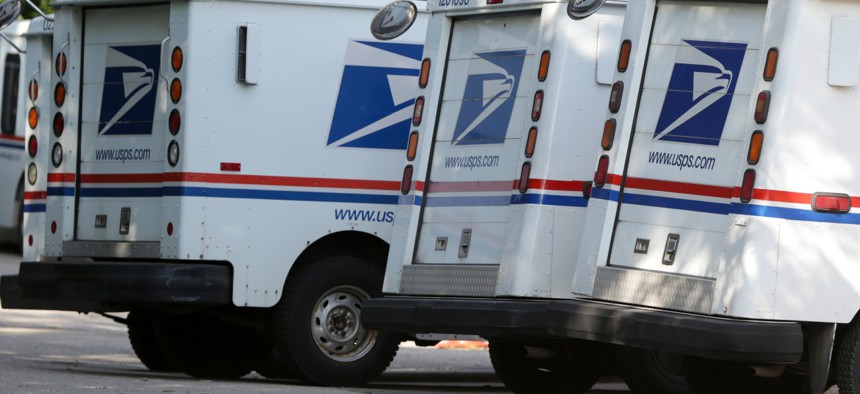
Jessica Rinaldi/The Boston Globe via Getty Images
The Postal Service and the White House are Fighting Over How Many Electric Vehicles to Buy
White House, EPA issue sharp warnings to the Postal Service over its fleet plans.
The Biden administration is ramping up pressure on the U.S. Postal Service to buy an electric vehicle fleet, sharply criticizing the mailing agency for flouting its required due diligence and failing to adequately account for its environmental impact.
In separate letters on Wednesday from the White House Council on Environmental Quality and the Environmental Protection Agency, Biden administration officials called on USPS to formally reassess its rationale for replacing 165,000 trucks and vans with internal combustion engine vehicles that have virtually no improved fuel economy from the decades-old vehicles it currently uses. Postal management’s process to date has violated the National Environmental Policy Act and CEQ regulations, EPA Associate Administrator Vicki Arroyo said.
The Postal Service last year awarded its fleet replacement contract for the manufacturing of at least 50,000 and up to 165,000 vehicles to Oshkosh Defense. The initial deal is worth $482 million, but USPS eventually expects to spend billions of dollars on the new fleet. USPS has committed to making just 10% of the new fleet electric, though Postmaster General Louis DeJoy has indicated he would be willing to go much further if Congress provided the funds.
EPA initially voiced concerns with USPS’ draft environmental impact statement, and Arroyo said those concerns were not addressed in the final version. The Postal Service withheld important data, declined to detail its economic and other assumptions and did not disclose specifics of the contract, she explained. Officials also underestimated the greenhouse gas emissions of the new fleet and the cost of mostly gas-powered vehicles, failed to consider all alternative options and neglected the environmental impact on local communities.
The Postal Service’s approach prevented “the public, federal agencies, and decisionmakers from understanding and evaluating the Postal Service’s ability and flexibility to purchase additional clean vehicles,” Arroyo said. She added the proposal “as currently crafted represents a crucial lost opportunity to more rapidly reduce the carbon footprint of one of the largest government fleets in the world.”
EPA and CEQ both called on postal management to craft a new impact study that took in account their concerns. The EPA letter included a series of specific shortfalls in USPS’ existing assessment and suggested remedies. They also both faulted the Postal Service for already giving Oshkosh $482 million before it even issued an impact study, in violation of environmental laws and regulations.
“The agency committed to walk down a path before looking to see where the path was leading,” CEQ Chair Brenda Mallory said in her letter. She called on USPS to “remedy deficiencies” in its plans, warning that it could face challenges from Congress and in federal court if it fails to do so.
Some of the changes can be “swiftly incorporate[d],” Mallory said, while others would be more difficult to address.
The White House and congressional Democrats have both proposed providing $6 billion for USPS to electrify its fleet, though the vehicle for that funding—the Build Back Better Act—remains in limbo. Biden has called on the entire federal government to switch to electric vehicles over the coming decades.
Mallory noted that many of USPS’ competitors have vowed to go entirely electric and suggested that even absent congressional action, the agency should be able to move forward with purchasing electric vehicles through its cash reserves or a “credit strategy.” Postal management has warned for a decade about its low cash-on-hand, though that total has skyrocketed in the last two years and sat at $23 billion at the end of 2021. USPS is straddled with debt in large part due to missed statutorily required payments to its fund health care benefits for future retirees, but Congress is planning to vote on a bipartisan bill next week that would erase much of those negative balances.
Kim Frum, a USPS spokeswoman, said the agency has already consulted with EPA throughout the development of its environmental impact statement and would review the agency’s concerns to see if they might “warrant further consideration.” She added, however, that management believes it has “fully satisfied” its requirements and the Biden administration is simply voicing policy disagreements. She reiterated that USPS would be willing to purchase more electric vehicles if it can do so in a manner that is “not financially detrimental to the Postal Service.”
“While we can understand why some who are not responsible for the financial sustainability of the Postal Service might prefer that we acquire more electric vehicles, the law requires us to be self-sufficient,” Frum said. “For that reason, given our current financial condition, the total cost of ownership of our delivery vehicle fleet must be a part of our analysis.”
EPA and CEQ disagreed with that assessment and warned USPS not to move forward with purchasing vehicles before further consultation with the administration and a public forum to review its plans.
“EPA has determined that the final [environmental impact statement] lacks disclosure of important underlying information, contains serious deficiencies, and the Postal Service should not proceed to a decision,” Arroyo said.







